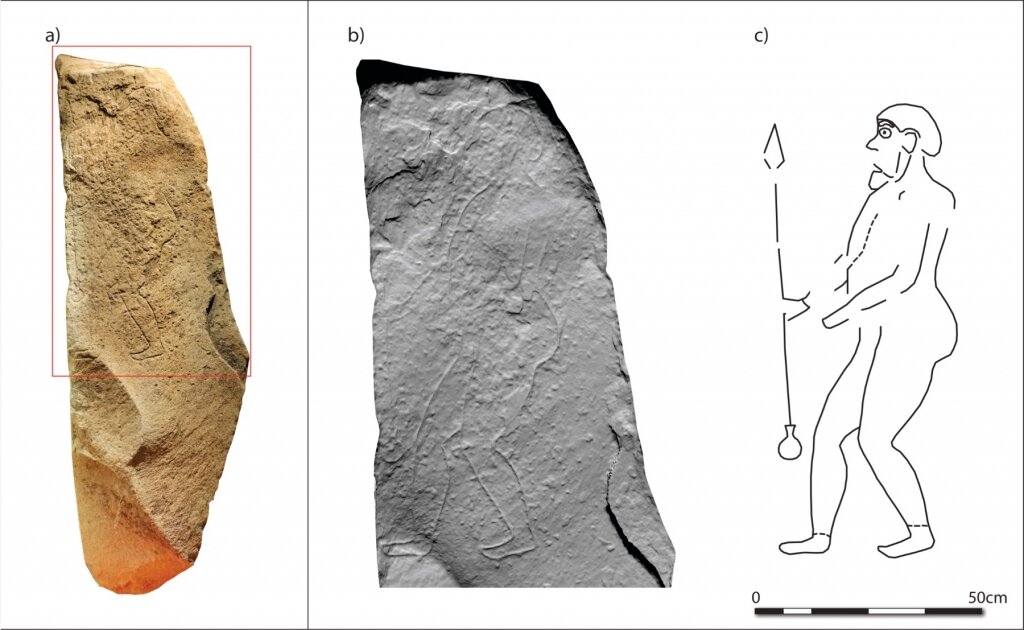Archaeologists have meticulously pieced together the details on a weathered Pictish stone, offering invaluable insights into the warrior culture of this enigmatic civilization. This chance discovery during road construction work near Perth, Scotland, has unearthed a new chapter in the country’s Pictish past.
The nearly two-meter-tall monolith, dubbed the Tulloch Stone after its find location, depicts a male figure holding a spear. While the initial outline was visible, years of exposure had dulled the carvings and chipped away at the stone’s surface. To overcome this challenge, archaeologists from the University of Aberdeen, leading the study of Northern Picts, took a meticulous approach.
Using a sophisticated technique, they captured thousands of photographs to create detailed 3D images. This digital reconstruction not only clarified the design elements but also enabled comparisons with other known Pictish stones.
Professor Gordon Noble, Head of Archaeology at Aberdeen, and Dr. Mark Hall, archaeological curator at Perth Museum, believe the Tulloch Stone is a significant find that enriches the existing body of Pictish material. Their research, published in the journal Antiquity, highlights the crucial role the stone plays in “filling the gaps” of Scotland’s undocumented history.
The intricate details revealed through 3D imaging offer a wealth of information. The figure on the Tulloch Stone is depicted carrying a distinctive “door-knob butted spear,” a weapon type known to be used between the 3rd and 6th centuries AD. Additional details include a unique hairstyle, a helmet, a necklace, and a faint line around the ankle, possibly indicating footwear or leggings.
Professor Noble emphasizes the warrior symbolism ingrained in the stone’s design. He points out that the Tulloch Stone’s location, overlooking the confluence of the Rivers Tay and Almond – a historically significant spot marked by a Roman fort and a potential Pictish royal center – suggests it might have been part of an elite cemetery.
The standardized presentation of figures across various Pictish stones, he argues, leans towards a “generic sacred image” rather than a specific individual buried there. Dr. Hall builds upon this notion, suggesting a hitherto unseen “war lord or warrior ethos” reflected in the stone.
While warrior culture has been extensively documented in Anglo-Saxon England, with iconic examples like the poem Beowulf, such evidence has been scarce in Scotland. The Tulloch Stone, along with a re-examination of existing stones, provides a “warrior ideology cast in stone,” signifying that these martial values were prominently displayed in the landscape, perhaps to invoke supernatural protection.
Professor Noble highlights the significance of the Tulloch Stone in bridging a critical knowledge gap. While the importance of warrior ideology in Pictish rulership is acknowledged, its evolution through the pre-6th and 7th century period, before historical records emerge, remained unclear. The weapon-wielding figures on these stones, he believes, could represent a war-oriented social structure that played a crucial role in resisting Roman influence and paving the way for the hierarchical societies that emerged after the Roman era.
The Tulloch Stone, unearthed during construction work for the A9/A85 scheme, is currently undergoing further research and conservation. It’s slated for display in a new Perth museum scheduled to open in 2022.
Dr. Mark Hall emphasizes the growing public awareness of Scotland’s Pictish heritage, which is leading to new discoveries. He commends the construction workers who recognized the significance of the stone and alerted the authorities. This vigilance, he suggests, is key to uncovering more Pictish stones, each one adding a valuable piece to the historical puzzle.
The discovery of the Tulloch Stone, with its newly revealed details, has not only provided a fresh perspective on this specific monument but also prompted a reconsideration of existing related sculptures. This holistic approach fosters new insights and conclusions that wouldn’t be possible by studying individual stones in isolation. The freely available research paper allows everyone to delve deeper into this exciting discovery and gain a deeper understanding of Scotland’s Pictish past.
Source: University of Aberdeen
